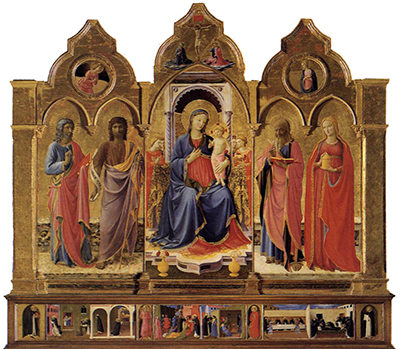The Cortona Triptych dates from 1436–1437 and features a number of different panel paintings by Fra Angelico which were arranged together as part of a larger display. There were three main panels with predellas across the foot of the design.
One can immediately identify the Madonna and Child within the central panel, with the former dressed in blue attire which was a common method by which Renaissance artists would help us to identify this figure within their paintings. Fra Angelico would do similar many times across his career and truly exhausted this theme, just as Sandro Botticelli would do with his own variety of Madonna and Child depictions. This delightful artwork is now to be found at the Diocesan Museum in Cortona, Italy. Records have shown that the paintings were created in Fiesole, a small town on the outskirts of Florence, before then being shipped over to Cortona, which itself is a hilltop town, also in Tuscany, Italy, so this would have been a relatively short journey at th time. Comparisons of this work have also been made with the artist's Perugia Altarpiece, with many similarities between the two artworks that came about just around a year apart.
The triptych format was common in the Renaissance era across Europe, with North European artists such as Van Eyck and Bosch using it particularly often. Installed religious art was one of the main formats during this period and winged artworks allowed painters to produce items that could be viewed from different angles which then worked well in some of these churches. Other examples of how they would adapt their work would be in frescos that shaped around existing features of a building rather than being delivered in a standard, rectangle format as we saw so often afterwards, as the influence of religion in art slowly started to reduce.
A predella is a small artwork which often are used in combination to line across the foot of an artwork. They were particularly common in the Renaissance era and on some occasions the master would call upon the services of his assistants to produce some of those items whilst he concentrated on the main panel. They would be created separately, and then later arranged together once the wooden installation was ready. It is therefore worth tackling each artwork individually, as well as studying the overall theme of this triptych. The content used across the predella follows the theme of the story of Saint Dominic, with specific titles of each panel being as follows:
- Saint Peter Martyr
- The dream of Innocent III
- Saint Michael the Archangel
- Resurrection of Napoleone Orsini
- Saint Vincent, Martyr
- Saint Dominic with the Friars, being served by the Angels and Death of St. Dominic
- Saint Thomas Aquinas




